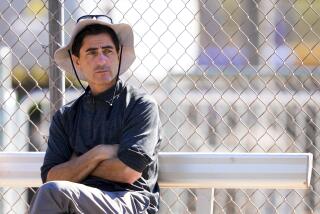Can Craigs Pull Padres’ Weight?
Jenny Craig and her husband, Sid, are trying to do with diets what Ray Kroc did with hamburgers--make them available to a large number of people at a relatively low cost.
And they are also trying to do what he did with the Padres--own them.
Padre players now joke about Lean Cuisine in the clubhouse, aerobics before batting practice and calorie counting after shagging flies.
Jenny Craig Inc. has been one of the fastest growing companies in the nation. Revenues have increased by more than 50% in each of the past three years. The company had revenues in excess of $150 million for the fiscal year that ended June 30, 1989. Assets reached almost $14 million in the 1988 fiscal year, or more than triple the previous year’s. The company’s net worth was listed at $3.5 million last year.
Is that enough for them to play in the big leagues?
“I’d think they’d have to have other financial sources,” said Cedric Tallis, a former general manager of the New York Yankees and the Kansas City Royals and now executive director of a Tampa Bay group seeking financing for a baseball franchise. “No. 1, they’ve got to have beaucoup bucks and be baseball enthusiasts. It’s a tough racket, it takes a lot of money to ante into the game.”
But company officials are quick to point out that Jenny Craig International Weight Loss Centres would not own the major league baseball team. Del Mar residents Jenny and Sid Craig would.
Attorney Jerry Kapstein, negotiating the sale for his mother-in-law, Padre owner Joan Kroc, is expected to finalize it after the holidays, sources said.
But Kapstein refused to divulge even if the Craigs are involved in negotiations, although the Craigs have told friends and associates that they will be the new owners.
Jenny and Sid Craig quietly built one of the top diet chains in the burgeoning weight-loss industry, which cashes in on the weight-loss hopes of an estimated 48 million Americans. But today, with their interest in buying the Padres, their low profile is rising.
“I never heard of Jenny Craig until all this stuff about the Padres--it’s a wonderful public relations opportunity,” said one former baseball executive. “Ray Kroc used to say whatever he spent on purchasing the team, he got millions back in publicity for McDonald’s hamburgers. It’s crazy what happens in the sports pages.”
As rumors fly about the Craigs buying the Padres, the two have sought shelter at their Aspen, Colo., vacation home. Both Craigs, now on a skiing vacation, have declined requests for interviews.
Kroc normally dislikes advance publicity on big business deals. She assumed ownership of the team in 1984 after the death of her husband.
Are Jenny, the dame of diets, and Sid, a former dance instructor, the stuff of Padre owners?
Today, a smorgasbord of people own major league baseball teams. Marge Schott, who owns a car dealership in Cincinnati, also owns the Reds. The president’s son, George W. Bush, heads a group that owns the Texas Rangers. Gene Autry, who played in cowboy movies and sang, owns the Angels.
There’s even a precedent for a diet king owning a professional sports franchise--Harold Katz, founder of Nutri/System, purchased the Philadelphia 76ers of the NBA in July 1981. For most team owners, though, the common denominator is money--and lots of it.
Some sources say the couple might not have enough money to swing the deal but that they have a New York partner, a tidbit--not yet proven--that spurs wild speculation in baseball circles.
The Padres are selling for about $100 million, said Steven Matt, manager of appraisals and valuations at the Arthur Andersen & Co. in Dallas. But the expense does not stop there.
As part of the criteria for the team’s sale, major league owners request that new owners have $200 million in operating revenue.
According to Fortune magazine, Jenny Craig Inc. earned $30 million in pre-tax profits during 1988 on revenues of $200 million. During that year, Inc. magazine touted Jenny Craig as the sixth-fastest growing private company in the country, basing its rating on the young company’s 21,000% growth from the previous year. As the company’s growth began to slow in 1989, the rating dropped to 448th.
Earlier this year, the company completed private placement of $100 million in secured and unsecured debt securities with a group of lenders: T.A. Associates of Boston, New York Life Insurance, Security Pacific National Bank and the Bank of New York.
For the Craigs, particularly Sid, the move to baseball is a natural one. Sid has always loved baseball and, as a treat, occasionally takes employees to games. His colleagues describe him as a fairly laid-back fan.
“He’s not a screamer,” said Coleman Kane, director of advertising for the San Diego-based company.
To beef up his knowledge of the baseball industry and learn about the minor leagues and scouting operations, Sid Craig, 57, met recently with a former general manager of a major league team.
“The man is a marketing genius--if it were up to me, I’d give him the team,” said the former general manager, who asked that his name not be published.
As the sports grapevine buzzes, the questions center on the identity of the Craigs’ supposed partner and whether the couple is, in fact, the leading contender in the field of potential buyers.
The Padres, who sold for $12 million in 1974, are considered to be among the top franchises in the major leagues. In 1989, they drew two million fans for the second time in history. Although the club does not release a profit-loss statement, it made about $4 million profit for the fiscal year ending Oct. 31.
According to sources in the baseball industry, the Padres have made a profit in five of the past six years. Their TV and radio revenue also will double beginning next season, providing about $18 million from national, local and cable broadcasting outlets.
Broadcasting revenue alone would cover the player payroll for the 1990 season. They mailed all their player contracts and already have their 10 highest-priced players signed in 1990 for a total of $10.3 million.
A sale cannot be officially consummated until the major league owners’ quarterly meeting March 7 in Dallas. The 12 National League teams must approve the sale by three-quarters majority; the 14 American League teams can approve it by simple majority.
The league will require the Padres’ new owner to have a significant “community identification” and name one person as ultimately responsible for all club decisions, according to a spokesman from the baseball commissioner’s office.
The Padres, meanwhile, remain mum on the sale. They were caught off-guard when Kroc announced Oct. 17 that she had put them on the market and in the two months since have remained in the dark about negotiations.
“All we know is from what we hear and read in the newspapers,” said Jack McKeon, manager and vice president for baseball operations.
McKeon and Padre players are anxious to see the deal finalized, so they’ll know who their boss will be for the 1990 season.
“I just want to see this thing get done,” said right fielder Tony Gwynn, who has been in the Padre organization since 1981. “Hopefully, the new owners will understand that although this is a business operation, you can’t run it like any other business. You’ve got to have an open-minded owner who knows that things in baseball change constantly, from salaries to players to managers.”
The Craigs are accustomed to change. Today, Jenny drives a 1989 Rolls Royce sedan, and Sid tools around in a 1987 Porsche, but they both hail from modest roots. As Sid grew up in Vancouver, Canada, his mother and father worked in a dress shop, according to previously published reports. Jenny’s father worked three different jobs in her hometown, Berwick, La.
Stationed at Coronado by the Navy, Sid taught dancing in the evenings at an Arthur Murray studio. After high school, Jenny worked at a dental clinic, and at 22, she married. In her first marriage, she gained 45 pounds during a difficult pregnancy.
“I wanted to prove to myself and my family that I could get back into my pre-pregnancy shape,” said Jenny, 56. “It was easy to motivate myself when none of my clothes fit even months after the baby was born.”
Jenny joined a health club and worked out with such enthusiasm and dedication that the gym owner offered her a job helping others lose weight. Within several years, Jenny owned and managed her own facility in New Orleans--a spot she gave up in 1978 to come to Los Angeles-based Body Contour Inc. There, she met Sid Craig, then president of the company. One year later, they married.
Their marriage became a business partnership as well. Jenny exudes a charm that fosters fierce loyalty among dieters and friends, colleagues say. Many describe her as the “people person” who strives to make the diet centers warm, supportive environments and writes personal thank-you notes to clients. Sid is credited with being the marketing whiz. The two, both workaholics, are athletic and enjoy skiing and tennis. They also like watching their race horses run at Del Mar.
The Craigs sold Body Contour, and because of a non-competition clause that prevented them from setting up shop in the United States, they moved to Australia and spent one year and $1 million developing a line of diet foods. On May 9, 1983, they launched their effort by opening nine centers in Melbourne. But there were problems. The government forced the Craigs to discard 100,000 boxes of vitamins because they contained a substance that requires a prescription in Australia.
The centers were not immediately successful in Australia, a country unfamiliar with weight-loss centers before the Craigs’ arrival. But after a marketing blitz, the company took hold. Today, Jenny Craig has 96 centers in Australia, 30 in England and 11 in New Zealand.
In 1985, the couple returned to the United States to kick off their business and garner a piece of what is currently a $1.5 billion industry annually. Though there are currently 269 U.S. Jenny Craig centers, company officials hope to expand to 1,000 by the year 1995.
The Craigs found and catered to a changing orientation in dieting. In 1986, 65 million--or about one in three--Americans said they were dieting, according to the Calorie Control Council, a group that represents diet food manufacturers. Today, that number has dropped to one in four.
“We have a changing perception of what dieting means--what used to be considered a diet is now considered a healthy life style,” said Keith Keeney, council spokesman. “There is a different dieter out there who is not looking for a miracle weight loss. Many want the Jenny Craig approach that helps with behavior and offers support.”
Under the Craig program, clients pay $185 and receive group and individual counseling. Until half the desired weight is lost, clients purchase only Jenny Craig meals, pre-packaged and frozen foods. A week of Craig cuisine costs between $50 to $75.
And like many diets, some people swear by it, including movie star Elliot Gould and LA Law’s Susan Rutan, both of whom have done television commercials for Jenny Craig. Television’s Ed McMahon, who is not a spokesman for the company, says he lost 30 pounds on the diet and that the food is delicious. McMahon, a 6-4 former football player, now weighs 200 pounds.
Even if the Craigs do buy the Padres, Gwynn, the 5-11 right fielder, mentioned no plans to start the Craig diet, though he is trying to slim down. But the four-time batting champion said he welcomes a new regime.
“As long as they’re committed to keeping the club in San Diego and keeping a winning team on the field,” he said, “that’s all we can ask for.”
More to Read
Go beyond the scoreboard
Get the latest on L.A.'s teams in the daily Sports Report newsletter.
You may occasionally receive promotional content from the Los Angeles Times.










